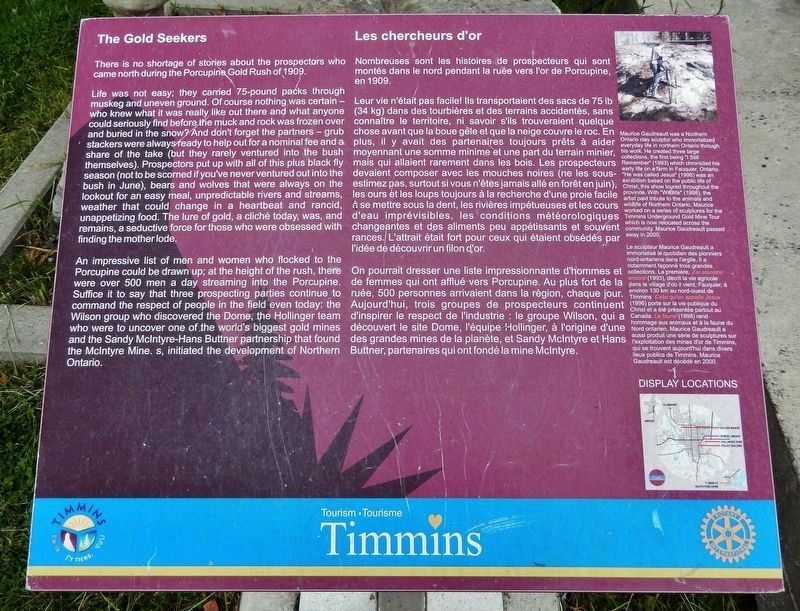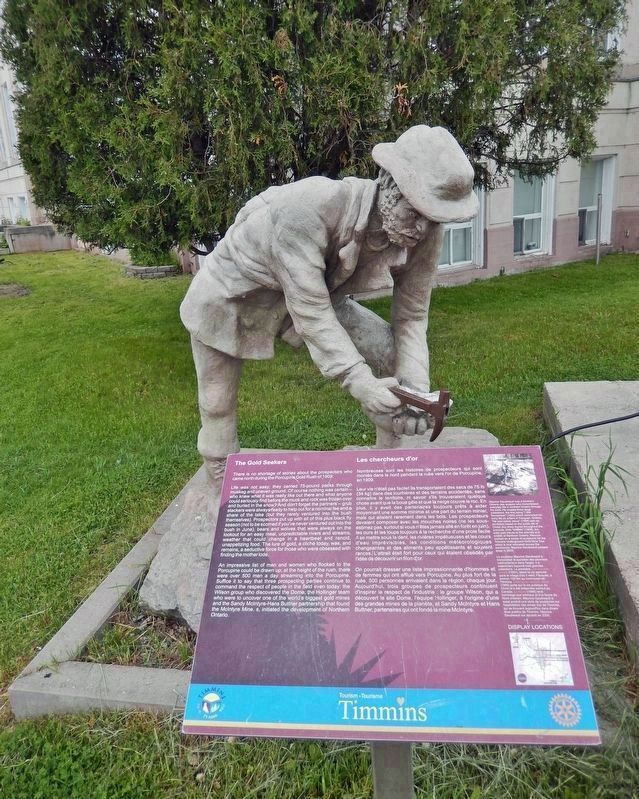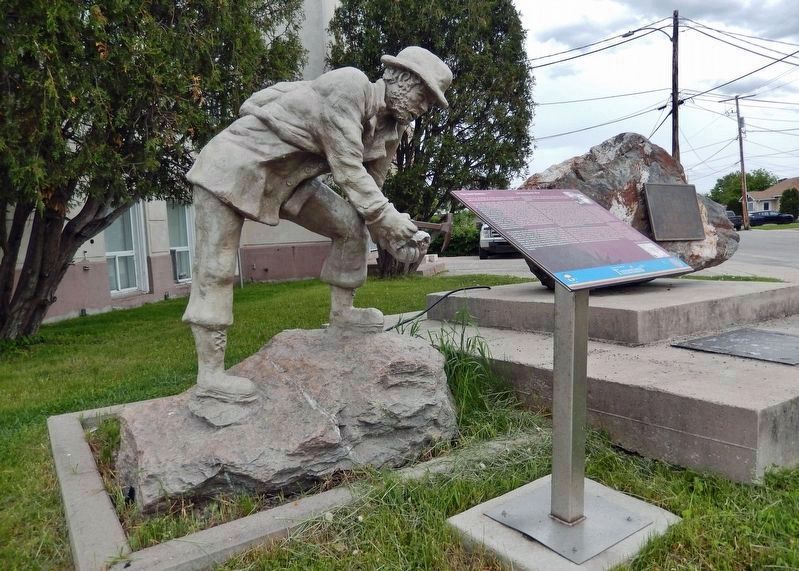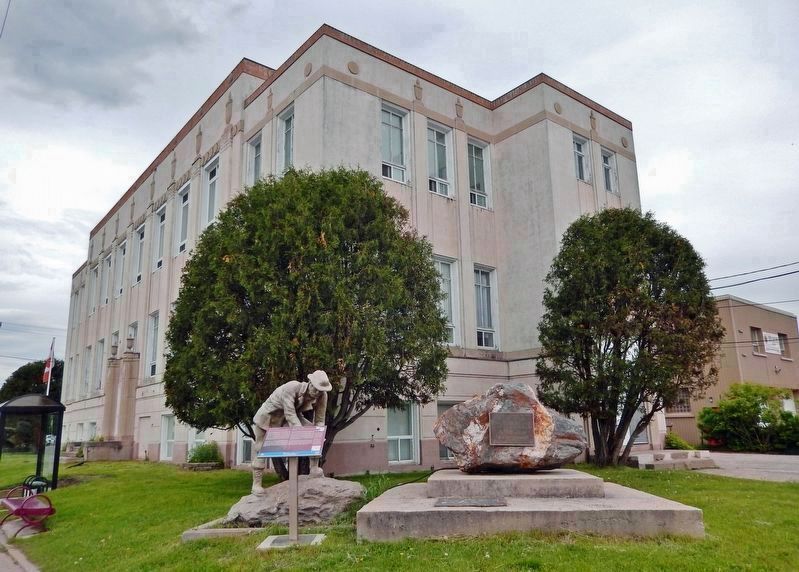South Porcupine in Cochrane District, Ontario — Central Canada (North America)
The Gold Seekers / Les chercheurs d'or
Life was not easy; they carried 75-pound packs through muskeg and uneven ground. Of course nothing was certain — who knew what it was really like out there and what anyone could seriously find before the muck and rock was frozen over and buried in the snow? And don't forget the partners — grub stackers were always ready to help out for a nominal fee and a share of the take (but they rarely ventured into the bush themselves). Prospectors put up with all of this plus black fly season (not to be scorned if you've never ventured out into the bush in June), bears and wolves that were always on the lookout for an easy meal, unpredictable rivers and streams, weather that could change in a heartbeat and rancid, unappetizing food. The lure of gold, a cliché today, was, and remains, a seductive force for those who were obsessed with finding the mother lode.
An impressive list of men and women who flocked to the Porcupine could be drawn up; at the height of the rush, there were over 500 men a day streaming into the Porcupine. Suffice it to say that three prospecting parties continue to command the respect of people in the field even today: the Wilson group who discovered the Dome, the Hollinger team who were to uncover one of the world's biggest gold mines and the Sandy McIntyre-Hans Buttner partnership that found the McIntyre Mine, partners that initiated the development of Northern Ontario.
Maurice Gaudreault was a Northern Ontario clay sculptor who immortalized everyday life in northern Ontario through his work. He created three large collections, the first being "I Still Remember" (1993) which chronicled his early life on a farm in Fauquier, Ontario. "He was called Jesus" (1996) was an exhibition based on the public life of Christ; this show toured throughout the province. With "Wildlife" (1998), the artist paid tribute to the animals and wildlife of Northern Ontario. Maurice worked on a series of sculptures for the Timmins Underground Gold Mine Tour which is now relocated across the community. Maurice Gaudreault passed away in 2000.
Leur vie n'était pas facile! Ils transportaient des sacs de 75 lb (34 kg) dans des tourbières et des terrains accidentés, sans connaître le territoire, ni savoir
s'ils trouveraient quelque chose avant que la boue gèle et que la neige couvre le roc. En plus, il y avait des partenaes toujours prêts à aider moyennant une somme minime et une part du terrain minier, mais qui allaient rarement dans les bois. Les prospecteurs devaient composer avec les mouches noires (ne les sous-estimez pas, surtout si vous n'êtes jamais allé en forêt en juin), les ours ét les loups toujours à la recherche d'une proie facile à se mettre sous la dent, les rivières impétueuses et les cours d'eau imprévisibles, les conditions météorologiques changeantes et des aliments peu appétissants et souvient rances. L'attrait était fort pour ceux qui étaient obsédés par l'idée de découvrir un filon d'or.
On pourrait dresser une liste impressionnante d'hommes et de femmes qui ont afflué vers Porcupine. Au plus fort de la ruée, 500 personnes arrivaient dans la région, chaque jour. Aujourd'hui, trois groupes de prospecteurs continuent d'inspirer le respect de l'industrie : le groupe Wilson, qui a découvert le site Dome, l'équipe Hollinger, à l'origine d'une des grandes mines de la planète, et Sandy Mclntyre et Hans Buttner, partenaires qui ont fondé la mine Mclntyre.
Le sculpteur Maurice Gaudreault a immortalisé le quotidien des pionniers nord-ontariens dans l'argile. Il a notamment façonné trois grandes collections. La première, J’ai souvenir encore
(1993), décrit la vie agricole dans le village d'où il vient, Fauquier, à environ 130 km au nord-ouest de Timmins. Celui qu’on appelle Jésus (1996) porte sur la vie publique du Christ et a été présentée partout au Canada. La faune (1998) rend hommage aux animaux et à la faune du Nord ontarien. Maurice Gaudreault a aussi produit une série de sculptures sur l'exploitation des mines d'or de Timmins, qui se trouvent aujourd'hui dans divers lieux publics de Timmins. Maurice Gaudreault est décédé en 2000.
Erected by Timmins Tourism and Rotary Club International.
Topics and series. This historical marker is listed in these topic lists: Arts, Letters, Music • Exploration • Industry & Commerce • Settlements & Settlers. In addition, it is included in the Rotary International series list. A significant historical year for this entry is 1909.
Location. 48° 28.73′ N, 81° 12.619′ W. Marker is in South Porcupine, Ontario, in Cochrane District. Marker is at the intersection of Main Street and Bloor Avenue, on the left when traveling south on Main Street. Marker and sculpture are located at southwest corner of the former Tisdale Municipal Office Building grounds. Touch for map. Marker is at or near this postal address: 71 Main Street, South Porcupine ON P0N 1H0, Canada. Touch for directions.
Other nearby markers. At least 8 other markers are within 11 kilometers of this marker
, measured as the crow flies. Tisdale Township Municipal Building (here, next to this marker); The Porcupine Fire / L'incendie de Porcupine (approx. half a kilometer away); Porcupine Mining Area / Région minière de Porcupine (approx. 3.3 kilometers away); Ore From the Kidd Creek Mine (approx. 6.5 kilometers away); "The Big Three" / Les trois principales mines (approx. 8.1 kilometers away); Gold Mining in Canada / Production de l'or au Canada (approx. 8.6 kilometers away); Shania Twain (approx. 8.6 kilometers away); The Porcupine Gold Rush / La Ruée vers l'or de Porcupine (approx. 9.9 kilometers away). Touch for a list and map of all markers in South Porcupine.
Related markers. Click here for a list of markers that are related to this marker. Timmins Heritage Tour
Also see . . .
1. Porcupine Gold Rush. Excerpt:
The Porcupine Gold Rush took place in Northern Ontario starting in 1909 and developing fully by 1911. The mines peaked between the 1940s and the 1950s but still continue to produce gold although the many smaller mines have been consolidated into a small number of larger holdings. By 2001, 67 million troy ounces of gold have been mined from the Porcupine area, making it by far the largest gold rush in terms of actual gold produced. For comparison, the well-known Klondike Gold Rush produced about 12 million troy ounces. The Porcupine rush, along with the Cobalt Silver Rush and Kirkland Lake Gold Rush, all in the early 20th century, drove most of the settlement effort in northern Ontario.(Submitted on June 4, 2022, by Cosmos Mariner of Cape Canaveral, Florida.)
2. Maurice Gaudreault (1932–2000). Excerpt:
(English translation) At 14, like many young people of his generation, Maurice left school to go to the construction site and pursue a thousand and one trades. In the early 1980s, Maurice Gaudreault became an artist in residence at the Kapuskasing Recreation Center. This artist immortalized the history of the pioneers of Northern Ontario using the medium he loved and knew best: clay. (Paul-François Sylvestre)(Submitted on April 6, 2024, by Cosmos Mariner of Cape Canaveral, Florida.)“Maurice often told me that he wrote the history of Northern Ontario in his own way and that he wanted young people to remember the past.” As I recount in the book I wrote in 2002 entitled Maurice Gaudreault, a sculptor of stories, Maurice was, in my opinion, a pioneer in the art of telling the story of our ancestors. He did not resort to words or literature. He used the material he particularly liked: earth! (Stéphane Laberge)
Credits. This page was last revised on April 6, 2024. It was originally submitted on June 4, 2022, by Cosmos Mariner of Cape Canaveral, Florida. This page has been viewed 86 times since then and 21 times this year. Photos: 1, 2, 3, 4. submitted on June 4, 2022, by Cosmos Mariner of Cape Canaveral, Florida.



